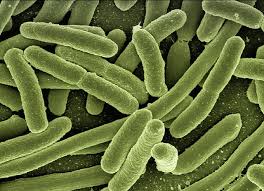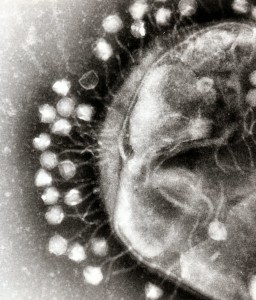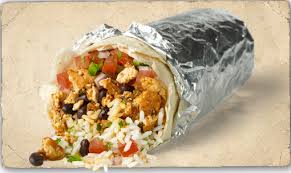 You may have read The Andromeda Strain or saw the movie: Astronauts go into space and bring back a plague that nearly wipes out civilization. There have been many movies made with that premise. What keeps me up at night is not the plagues from outer space; what keeps me up are the plagues that will come from this planet—they are likely to wipe us out.
You may have read The Andromeda Strain or saw the movie: Astronauts go into space and bring back a plague that nearly wipes out civilization. There have been many movies made with that premise. What keeps me up at night is not the plagues from outer space; what keeps me up are the plagues that will come from this planet—they are likely to wipe us out.
Consider the plagues of mankind: Yearly influenza, including the 1918 Spanish flu epidemic that killed more than the Great War; measles that still infects over 145,000 people world-wide; smallpox that used to ravage the population; or others like diphtheria, staphylococcus, Ebola, HIV, and more.
What do they all have in common?
They all come from our food. Mostly they originated when man domesticated animals for consumption, and these bugs were living inside these the animals. These viruses and bacteria then mutated and became the plagues of mankind.
Since livestock is close to humans on the evolutionary ladder, the ability to jump from one species to another is easy. We have our own Andromeda strain. We don’t have to go to another planet, and the next major plague is most likely residing peacefully in our animals.
My vegan and PETA friends will tell you this is why we should not raise animals for consumption, and should be eating only vegetables. They might neglect to tell you that fish have never been a source of a major plague; it turns out we are genetically far enough from fish that the diseases that infect them have never mutated to bother mankind. When you think about what foods we will bring to the next planet, chances are it will include fish, but more about that later.
When I was doing my graduate work in virology we learned all about viruses from measles to smallpox to herpes, and that even bacteria became infected with viruses. We learned that bacterial viruses (called phages) didn’t infect human cells because they were specific to bacteria.
At least that is what we were told.
It turns out that science was wrong.
Chipotle and Jack in the Box
The same bug that has forced the closure of 43 Chipotle Restaurants in the Pacific Northwest is the same one that caused problems with Jack in the Box.
Brianne was a healthy nine-year-old girl whose favorite food, like mine, was hamburgers. That week Jack in the Box had a special and she ate there twice. A few days later she began to feel ill, and when they noticed blood in her urine she was sent to Seattle’s Children’s Hospitals. She was admitted directly to the intensive care unit, where she was diagnosed with hemolytic uremic syndrome, a condition where the kidneys begin to fail after being exposed to a particular strain of the bacteria Escherichia coli, or E. coli. This young girl with the long dark hair and round red glasses began to get worse, and suffered multiple organ failure. Her parents were told several times that she wouldn’t make it, but despite three strokes and multiple seizures, she lived. She spent nearly five months in the hospital—and forty days of that time in a coma.
This all came from a bacterium that normally lives in the colon. The designation E. coli comprises a large and diverse species of bacteria with many strains. It’s commonly found in soil, on vegetables, and almost everywhere you care to look. So while it is there are some strains of these bacteria that are the stuff of a highly infectious disease, the vast majority of these bacteria you will find living harmlessly everywhere. Every year, on a slow news day, some reporter will get samples of beards, or coffee makers, or restaurant plates, and send off samples to a laboratory to see what they grow, and the lab will always report back there is E. coli, simply because it is everywhere. The report will set off headlines and internet feeds about “beard poop” or “clean your coffee maker.”
Most strains of E. coli are harmless, and in fact, were it not for the helpful E. coli in our colon, we would not survive.
However, some strains of E. coli can make you sick.
The bacteria that nearly killed Brianne, and is causing concern among Chipotle customers, is designated commonly as E. coli 0157. This started out as a normal E. coli, one that would not bother Brianne or anyone if ingested. But this bacterium was infected with a virus. A virus is little more than a protein package containing DNA that takes over a host cell to replicate its own kind. But this virus contained a bit of DNA that caused the E. coli to make proteins on its cell surface. If you look at these infected bacteria under an electron microscope you will see what appear to be tentacles on them, and it is those proteins that cause the toxicity that not only infected Brianne but killed four children in Washington, and made over five hundred people sick from the “undercooked” burgers.
Science would tell us that bacteria has to survive cooking, survive the stomach acid, and then come into the colon, where they find a place to live. The bacteria could have been stopped anywhere along the way. So why did that normal bacterium, commonly found everywhere, become infected with a virus and transform to Shiga-toxin producing E. Coli (STEC)? The bacteria E. coli strain 0157 can cause illness with as few as ten individual bacteria per gram of food. This is why most major burger chains think they need to cook their burgers to medium or medium-well.
It turns out that the sticky tentacle proteins that the virus makes are the problem. First, the proteins make it easier for these bacteria to stick to the cell surfaces of the crowded colon. It’s like having an advantage when playing musical chairs. Then those proteins are shed as the bacteria dies, and those proteins cause the following cascade in some people: the foreign protein is detected by the white blood cells, that then go through the wall of the colon to inactivate them. When those white cells cross into the colon they leave an opening for the toxic proteins, and those proteins enter and cause cell death of some cells. They are toxic to cells in the kidney, leading to the bloody urine. Just as Botox is toxic when it is ingested in large amounts, so is this bacterial toxin.
Also, when the bacterium dies, not only does it shed those toxic proteins, it is also releases hundreds more phages (viruses) that quickly infect the bacteria next door. And those viruses kill bacteria, which shed more proteins in less than ten minutes. So you can see how this microscopic problem in your gut can rapidly become a major problem.
Clearly the bacteria that’s been eaten isn’t the problem; it’s the bacteria viruses that take over the normal bacteria in the colon, making them into bacteria zombies that become toxin producing cells. So while the world is saying you need to heat the meat for the bacteria, it isn’t the bacteria that you should worry about; far more heat resistant than the bacteria are the viruses that infect the bacteria. To kill the bacteria alone, you just a few seconds at 145 degrees Fahrenheit, but for the bacteriophage you need higher temperature and longer exposure. Those bacteria phages are far more resistant to heat than the bacteria themselves. The recommendations to heat at 160 degrees F, making that burger medium to medium-well done, is enough to inactivate the proteins of the toxins and inactivate the virus that infects the E. coli.
Those bacteria phages also survive quite well in a stomach that isn’t producing much acid, which is another reason to get off the long-term use of drugs that completely suppress acid, such as protonix and omeprazole.

Small viruses that infect an E coli bacteria. It could be a normal E coli sitting in our gut that is infected with this little virus called a phage
Our microbiome has a fair bit of E. coli living peacefully with us, not causing us any problems. But that microbiome can be infected with a virus that transforms our happy bacteria into zombie bacteria, making evil proteins that make us ill. In other words, those bacterial viruses affect us by affecting our microbiome, and since our microbiome is a functioning “organ,” it turns out the conventional view about phages not bothering humans was wrong. It’s an elegant bit of nature revealed by science that shows us that we are more complex than just our structural cells alone.
It turns out that Shiga toxin doesn’t bother cows, not one bit. They can have those zombie bacteria and they will happily munch away. In some feedlots, twenty percent of the cows have E. coli 0157 and shed them in their stool. Now routine testing for these toxic proteins are performed by the meat packing industry, and recalls of beef occur before outbreaks (hopefully).
Consider that a bacterium infected with this virus can infect thousands of other bacteria in a few minutes. This virus grows and sheds quickly. So bacteria normally residing on your hands, kitchen counter tops, utensils, clothes, all become targets for this virus. This is why people have been infected by just visiting farms, or vegetables become a source of the toxin.
If you worry about a virus infecting humans, you should worry about the virus that infects our microbiome. It can spread quickly and cross contaminate your kitchen faster than you can imagine. They are tough, small viruses that are hard to kill, much harder than just bacteria. Using bleach on countertops does a great job, though.
The dairy industry has known about the effect of bacteriophages on the production of cheese and yogurt making for years. Ironically, it was from the dairy industry that we know the name of Louis Pasteur, who in 1864 showed that heat destroyed most of the bacteria that harm humans. But bacteriophages can kill bacteria in dairy products and cause fermentation failure, which is bad if you make cheese. The common recommendations for time and temperature for bacteria don’t work for killing the phages, and if you don’t kill them they can destroy the helpful bacteria.
You might think, why not give antibiotics when someone starts feeling ill after the lousy burger? It turns out most antibiotics actually cause the virus to be activated. Patients who have these bugs and get antibiotics often do much worse. With a stomach upset, it’s often better to let it run its course (“run” being the appropriate word for some abdominal upsets).
- Ecoli 0157 is only one of a number of bacteria that have these toxins. The entire group of Shiga toxigenic Escherichia coli (STEC) numbers several that cause damage to humans. They all work in a similar way—the proteins are toxic to human cells, and the bacteria that are a part of our gut are transformed by the virus that infects them and turns them into toxin producing factories.
So how do we combat them? Clearly food preparation is important—avoiding the most obvious sins by careful handling of products, hand washing, cleaning surfaces, and appropriate temperatures to inactivate the toxins. But science has come up with some better solutions.
Some solutions involve developing phages (bacterial viruses) that are modified so that they will produce receptors for the toxins that bind to them and render them harmless. Or developing binding proteins that bind to the toxins and can be given to someone in the midst of an epidemic. The problem with modifying bacterial viruses to do this (it has been done) is that they are considered genetically modified organisms, which becomes an issue for those who feel GMOs are evil and to be avoided at all costs. Alas, science sometimes shows us what we don’t expect, but in this case, science can provide a solution that prevents the worst Andromeda strain imaginable.
What about vaccinating the cows? It turns out that this helps, and the U.S. and Canada have approved vaccines that make cow stomachs less habitable for bacteria that contain those toxins. It greatly reduces the incidence of the shed toxins, but not completely. So far this has not been used widely, and it probably won’t until there is widespread consumer demand.
Meanwhile, bacterial viruses are busy doing their dirty work in other places. New Shiga toxins have come out of the Caribbean lately, with similar disasters for the people they infect.
While Brianne was in the hospital she saw on television a story about the outbreak of E. coli 0157, and she became angry that the hamburger she loved made her sick. In fact, she said, “I was mad as hell.” Today, she says that people need to be careful.
Every safety regulation could be put in place from when the calf is born to being slaughtered and processed until it hits the grill, and nature could still find a way for E. coli to get in there. The same is true for fruits and veggies and other foodborne illnesses. It’s ultimately up to the person cooking the food. Don’t blindly trust that the food is safe. Do your best to make sure it’s safe by cooking/washing it properly, and if you choose to undercook something, acknowledge that you are taking a risk and if you or someone else does get sick that you had an opportunity to prevent it. I’d like to reiterate that in restaurants and grocery stores you do need to trust that the food is safe, but don’t blindly trust.
The deadly E. coli 0157 has made people sick through food besides burgers. It has also infected people through unpasteurized milk, unpasteurized cheese, strawberries, raw pre-packaged cookie dough (oh, this one makes me sad), lettuce, prepared salads, bagged spinach, “washed-ready-to-eat lettuce,” homemade jerky, various restaurants, bottled water, Sizzler self-service salad bars, Chipotle, and McDonald’s. Just to name a few.
Some phages also contain the DNA that makes some bacteria resistant to antibiotics. So imagine this: these little viruses can transform a bacterium that can be killed with penicillin into a bacterium that can withstand the onslaught of the course of antibiotics given to you by your friendly doctor.
Foodborne Illness
Food poisoning (technically, we doctors call it foodborne illness) happens when we eat or drink something that is contaminated with bacteria, parasites, or viruses, or with some chemical that causes illness. Every year forty-eight million people in the United States become ill from food, 128,000 are hospitalized, and three thousand people die from foodborne illnesses. The economic loss from foodborne illness in the United States is estimated at $77 billion a year.
The first food processing was probably a caveman learning about fire and food. The fire served to sterilize the food while making it tasty, although it took a few millennia for man to learn this.
- E coli 0157 is one toxin, but you have heard of another classic food toxin, botulism, caused by the toxin produced by a bacterium called Clostridium botulinum. Made without the help of phages, this is a paralytic toxin whose early symptoms include difficulty swallowing or speaking, dry mouth, double vision, and trouble breathing. In the United States this is a more common problem for infants under one year of age who are given honey. Honey (contrary to what the natural health food people tell you) can harbor the botulinum spores that will hatch and grow in infants. Babies do not have the acid in their stomachs that normally destroys these spores, so they become the unwitting victims of botulism. Once children are one year old, their stomachs make enough acid to destroy those spores.
Meanwhile, adults are willing to pay hundreds of dollars to have this toxin injected in the muscles of their face to make them immobile (it’s called Botox).
While proper cooking kills bacteria and destroys viruses, high temperature has a competing interest with taste—a high temperature for a long period renders most meat unpalatable. For example, at 160˚ F the proteins of meat begin to dry out, and the longer they are exposed to this temperature the drier they become. Most prepared chicken has been made safe by overcooking—hence the chicken in soups or purchased from restaurants is often overcooked and dry.
At 122°F there are no bacteria that are pathogenic (cause illness) to humans that survive. However, in some hot springs there are certain bacteria that thrive at these higher temperatures. Fortunately these bacteria are not harmful to humans. Ironically they do not find the human host hospitable, because for them the human body is too cool, and they prefer temperatures much higher.
An effective way to combat bacteria is to deny them the ability to reproduce. At 102°F, while most bacteria can survive, they can no longer reproduce, which explains the protective nature of human fevers.
We once looked at food safety as being all about getting rid of bacteria, but it turns out we have to worry more about the viruses that infect the bacteria than we do the bacteria themselves. That means higher temperatures; so if you enjoy a burger, if you grind your own meat you’re probably okay.
Eventually, probably irradiation of food sources will prove the safest and most palatable way to eliminate the risk of the Andromeda strain—the one that is right there in the packaged meats and fruits and vegetables.


